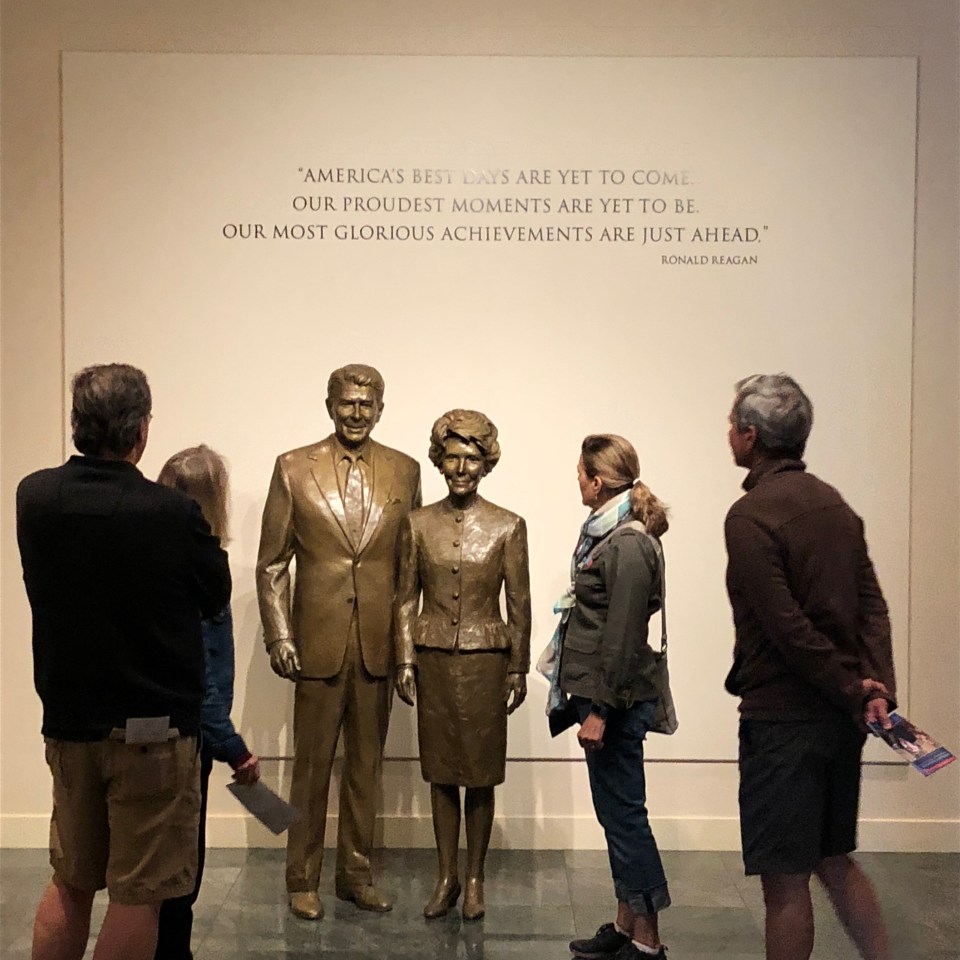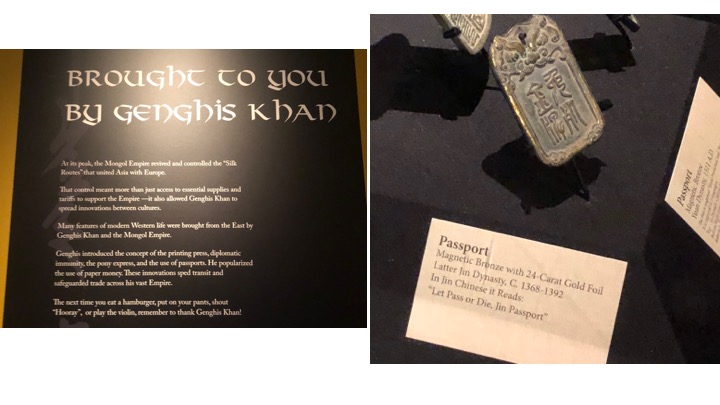My Two Favorite Colonizers Have An Awesome Group Show : Genghis Khan at the Ronald Reagan Library
A Short Meditation on How Time Vacillates and Collapses, from Silk Roads and Passports to Cointelpro to Oliver North’s New NRA to ICE. Presented in response to “Genghis Khan: The Exhibition” at the Ronald Reagan Library that was on view February 16th through August 19, 2018.
There is both a tone-deafness and deadpan-ness when art and academic institutions choose to present shows that align so well with their own historical narratives. Is it a form of reparations by museums founded on the merits of exploitation to exhibit work on their founders’ ill-doings? But this exhibition, atop a foothill in Simi Valley, California was so staunchly deadpan in its forthright defense of a colonizer who sizes up quite exponentially to those whose monuments we’ve collectively, in the left, sought to topple down in this country the last few years, that one can only imagine the institution’s conflating of two colonizers who seemingly have aligned philosophies.1
What begins to occur in this show is not a survey of indexed time or a conventional biography, but the beginnings of linear time and neighboring institution walls vacillating and collapsing – when we witness early implementations of passports on the Silk Road by Genghis Khan23 (which the exhibition’s didactics ask us to thank and praise him for) it’s not Genghis Khan we see, it’s the Reagan Foundation’s recognition of border walls, colonialism, and imperialism as models of efficacy, it’s 45’s4 active militarization upon urban neighborhoods by unleashing ICE, it’s Executive Order 13769, the 2017 Travel Ban better known as the Muslim Ban. These examples are rife and only amplify while walking through the seemingly linear exhibition and you begin to witness more of an institutional solidarity to imperialistic tendencies than you do individual biography.
Each moment indexed from points during Khan’s conquests can be networked and tangled back, and forward, through space to the walls which hold each didactic for this exhibition, in this case Reagan’s own conquests and his peripheries which outlast his presidency to the current one – enabling the conquests of White Cis Straight Able America.567891011
“Only in America can a little boy born to ordinary parents in America’s mid-west grow up to become a great leader, not only for our nation, but for our world. Ronald Reagan did extraordinary things with his ordinary upbringing. His story is one of “A Truly American Life”.
Ronald Reagan Foundation Website
And so, where we would imagine conversations around early global capitalism, or hemispheric capitalism, and models of dependency and exploitation that transformed into imperialistic tendencies on the Silk Road, we can also model Reagan’s facilitating of Oliver North’s selling of arms during the Iran-Iraq war to invest profits into Contras in Nicaragua to promote the Drug Wars in North America as a kaleidoscopic conflation of time, and space, networked and entangled between the two highlighted figureheads – Reagan and Khan.1213
How Reagan did not fail Black Americans, but targeted Black Americans – facilitating and yielding Oliver North’s machinations where great-grandchildren of an era will still feel the pain of the criminalized oppression the Drug Wars caused – perhaps pulls from the books of Khan himself. Even highlighted in the exhibition as a low point of his presidency, with his flat, formal apology to the American people (along with his pardoning of Oliver North, to immune him of all his illegal squanderings – of course, “diplomatic immunity” being of the many conventions brought to us by Khan), more than 30 years later this same man, Oliver North, will be chosen as president of the NRA. Our collective national amnesia entangled and emblazoned now with White Supremacist allies, the wall didactics in each of these men’s respective exhibitions with adjacent and neighboring walls now jerk us back into a fearful present where we see textbook imperialism – the profit off the pillaging of a land to fuel the pillaging of one’s own unwanted, here being Black and Brown and Queer bodies – deeper into the white spatial imaginary that consumed Reagan’s White America facilitating of the Drug Wars, and continues to threaten Black and Brown and Queer and Femme futurities this very moment.14
It isn’t the stout lack of criticality the exhibition didactics play down on Khan’s conquests, but the sheer defense and praise of his conquests and process, that are far more indicative of the Reagan Foundations philosophies on imperialism than even the website descriptions on the exhibition. Oddly, it’s the Reagan Foundation’s burrowing of this hole for themselves, an invitation to entice by promoting ill-pasts that align with their own, drawing parallels by themselves for themselves all while very well knowing the allegorical mirrorings between the figureheads they’ve chosen to exhibit.
Reagan and Khan’s tousled relation to arms wage heavy in intersections that feel more surreal than they do historical. Khan’s development of the first projectile MIRV tangled with the echo of antitank missiles delivered to Iran in exchange for hostages at the moment of Reagan’s inauguration fall flat to the realization of Reagan’s status on the NRA not during his presidency but before, which constitute heavily to anti-blackness in America.15 If we disregard the vacillating hyper-presence of the global, physical space where Oliver North’s domestic status as the head of the NRA and the looming sanctions 45 upholds to Iran which currently strike brash poverty and starvation in the wake of yet another war over petrocultures, the anchoring of such history lies in Black Americans being denied access to arms in response to the reception of the Black Panthers and Black Nationalists at the steps of the California Capital while Reagan being Governor of California at the time, all while snowballing the imposition to the strictest gun regulations – the Mulford Act of 1967 – in America.161718 These dispositions will go on to reflect the odd Interparliamentary Agreement of 1986, which was a failed attempt by Reagan to quell everything the alt-right stands for today to keep South Americans outside of the US – oddly, with dismay, this in no way consoles us to Reagan’s philosophies.19 What would catapult his presidency into a regime of white supremacy, an inauguration steeped in blackface simultaneously along with a global arms exchange, will manifest into what we experience today as a reprise of a Reagan Era on crack – the same crack he facilitated to let loose across America – and yield President 45.20
Through these circuitous relations we imagine time and space moves both ways if we choose to see through that lens, and so how can the lens of viewing this show model ways we see contemporary exhibitions and their respective institutions – what model does this show yield to the art institutions whose founders and donors we rarely critique and vet – and the shows they represent? Perhaps we can vet ourselves to consider the institutions at which we participate art viewing in – their historical contexts, their historical amends, what activities, programmings, and attempts have they made to erase their oil-driven, colonial-driven, drought-ridden identities – and the art object, despite its often anticapitalist sentiments, to not be synthesized as anything other than an object inherently colonial when seen under the facade of institutional provenance. To actively challenge this deduction. To imagine contemporary artists to not opt-out from systems of power but pressure systems of power to divest and realign – to erase their colonial past, perhaps beginning with their monuments, and names, to reposition monies to Black and Brown and Queer Futurities. And to re-imagine not the erasure or censorship of history steeped in ethnopessimism, but one which at least ceases to continue to valorize its history with the rhetoric of imperialist power structures as exemplary, to topple those monuments and to rename structures of wealth and power that had been made on the backs of the exploited to re-imagine ethnofuturities.
All photos Alexandre Dorriz, May 12th, 2018
- https://www.guidestar.org/profile/77-0054631 ↩
- Haining, Thomas Nivison., and Paul Ratchnevsky. Genghis Khan: His Life and Legacy. Malden, MA: Blackwell, 2006. ↩
- Whitfield, Susan. Life along the Silk Road. 2015. ↩
- *(Drawing from Patrisse Khan-Cullors, with whom we should all align to not validate the oppressive name of the 45th President of the United States) Khan-Cullors, Patrisse and Bandele Asha. When They Call You a Terrorist: A Black Lives Matter Memoir. S.1.: Canongate Books, 2018. ↩
- https://www.nytimes.com/1981/04/04/us/food-stamps-program-it-grew-reagan-wants-cut-it-back-budget-targets.html ↩
- http://www.povertyinsights.org/2013/10/14/did-reagans-crazy-mental-health-policies-cause-todays-homelessness/ ↩
- https://www.motherjones.com/politics/2013/04/timeline-mental-health-america/ ↩
- https://aphaih.org/2011/02/21/and-the-band-played-on-politics-people-and-the-aids-epidemic-book-review/ ↩
- http://www.jstor.org/stable/10.5149/9780807895474_brier.7 ↩
- http://www.jstor.org/stable/j.ctt46njgc.31 ↩
- http://www.jstor.org/stable/j.ctt14bt2gw.13 ↩
- Webb, Gary. Dark Alliance the CIA, the Contras, and the Crack Cocaine Explosion. New York: Seven Stories, 1998. ↩
- https://theintercept.com/2018/05/12/oliver-north-nra-iran-contra/ ↩
- Maghbouleh, Neda. The Limits of Whiteness Iranian Americans and the Everyday Politics of Race. Redwood City: Stanford University Press, 2017. ↩
- https://www.nytimes.com/2003/03/05/opinion/what-would-genghis-do.html ↩
- https://www.youtube.com/watch?v=wQhUiupJ67g ↩
- https://www.history.com/news/black-panthers-gun-control-nra-support-mulford-act ↩
- https://www.newsweek.com/president-ronald-reagan-nra-speech-1983-590529 ↩
- https://www.youtube.com/watch?v=8qwbhj1TlpE ↩
- https://www.newyorker.com/culture/culture-desk/revisiting-ben-vereens-misunderstood-blackface-inaugural-performance ↩






















There are no comments
Add yours